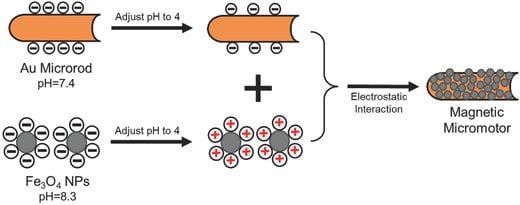Wei Wang from Harbin Institute of Technology, China, and colleagues have developed magnetically steerable, acid-resistant micromotors that can be fabricated by electrostatic attraction between magnetite nanoparticles and gold microrods at pH ≈ 4. These Fe3O4‐coated microrods can be powered by MHz ultrasound and controlled by magnetic fields, and resist acid degradation, so are therefore potentially useful for biomedical applications.
The task of monitoring and controlling micromotors once they are in the complex maze of human bodies remains a major challenge. External steering of magnetic micromotors offers a more controlled method of guidance, and has the potential to be broadly applicable. Nickel or cobalt coatings or segments have been widely used as magnetic layers to enable steering, as they can be incorporated into micromotor structures via physical or chemical deposition. However, Ni and Co are known to be highly chemically active and unstable in acidic environments, particularly detrimental in biomedical applications involving low pH environments. Magnetite (Fe3O4), on the other hand, is of low cytotoxicity, resists acid more effectively, and has magnetic properties suitable for steering magnetic micromotors.
The method developed to prepare the Fe3O4‐coated metal microrods (below) is simple, fast, and inexpensive and exploits the differences in microrod and nanoparticle surface charges at various pH values. The coating does not compromise the speed of the micromotor and studies in fluids of high viscosity and high ionic strength suggest the Fe3O4‐coated ultrasound micromotors could be useful as biocompatible micromachines.


















